Sir John Monash, Personal Files Book 15, 1 April - 10 May 1917, Part 5

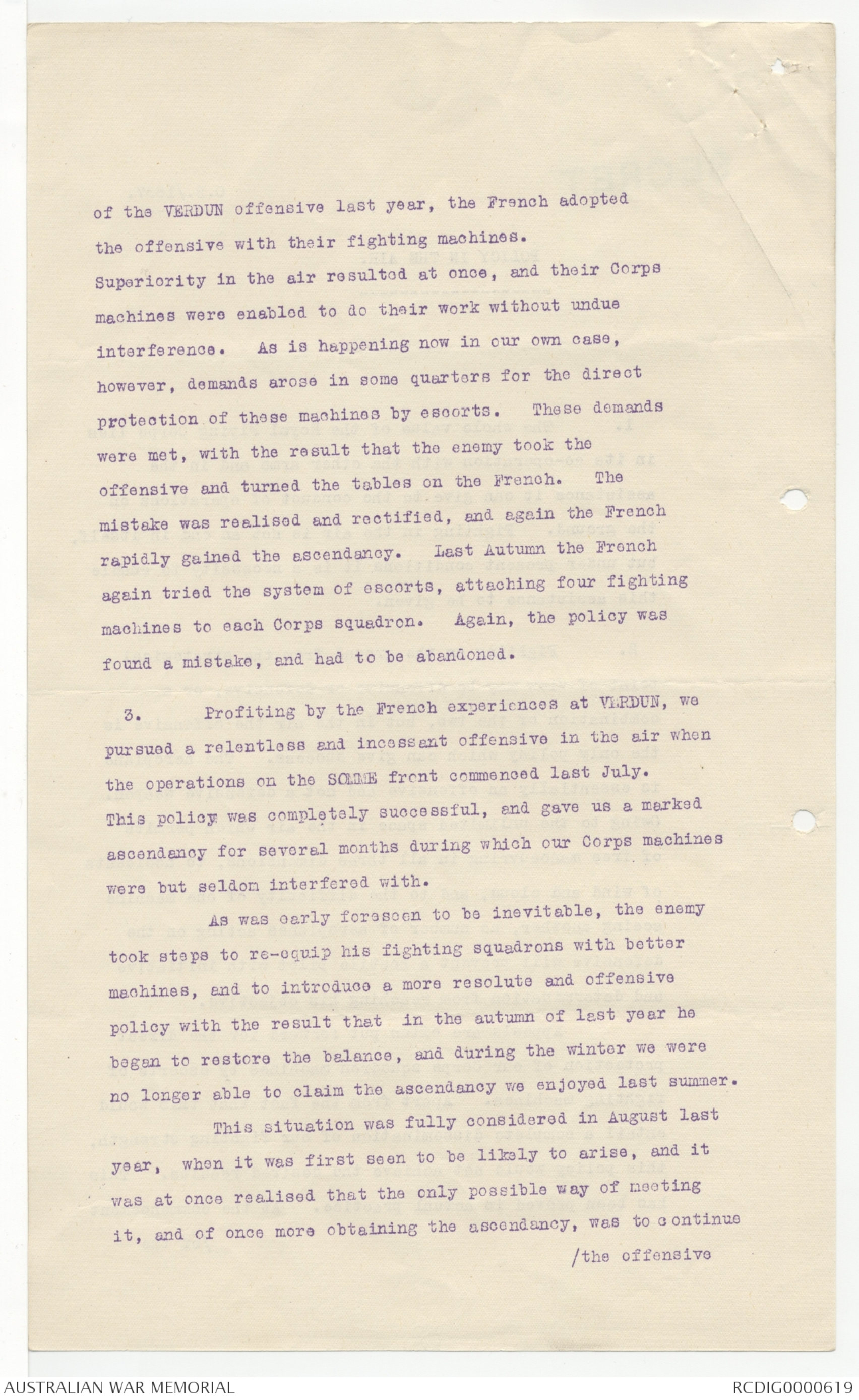
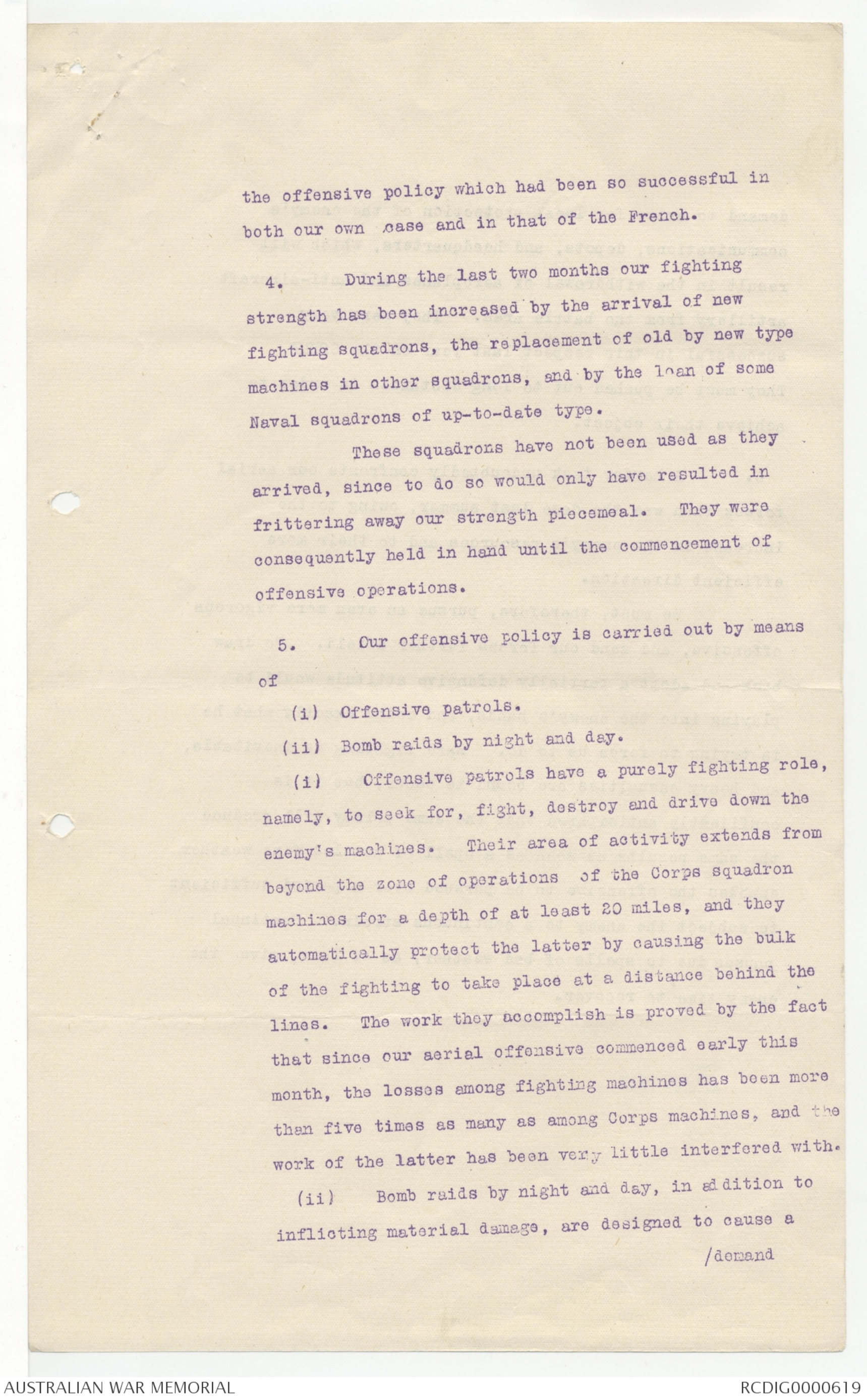
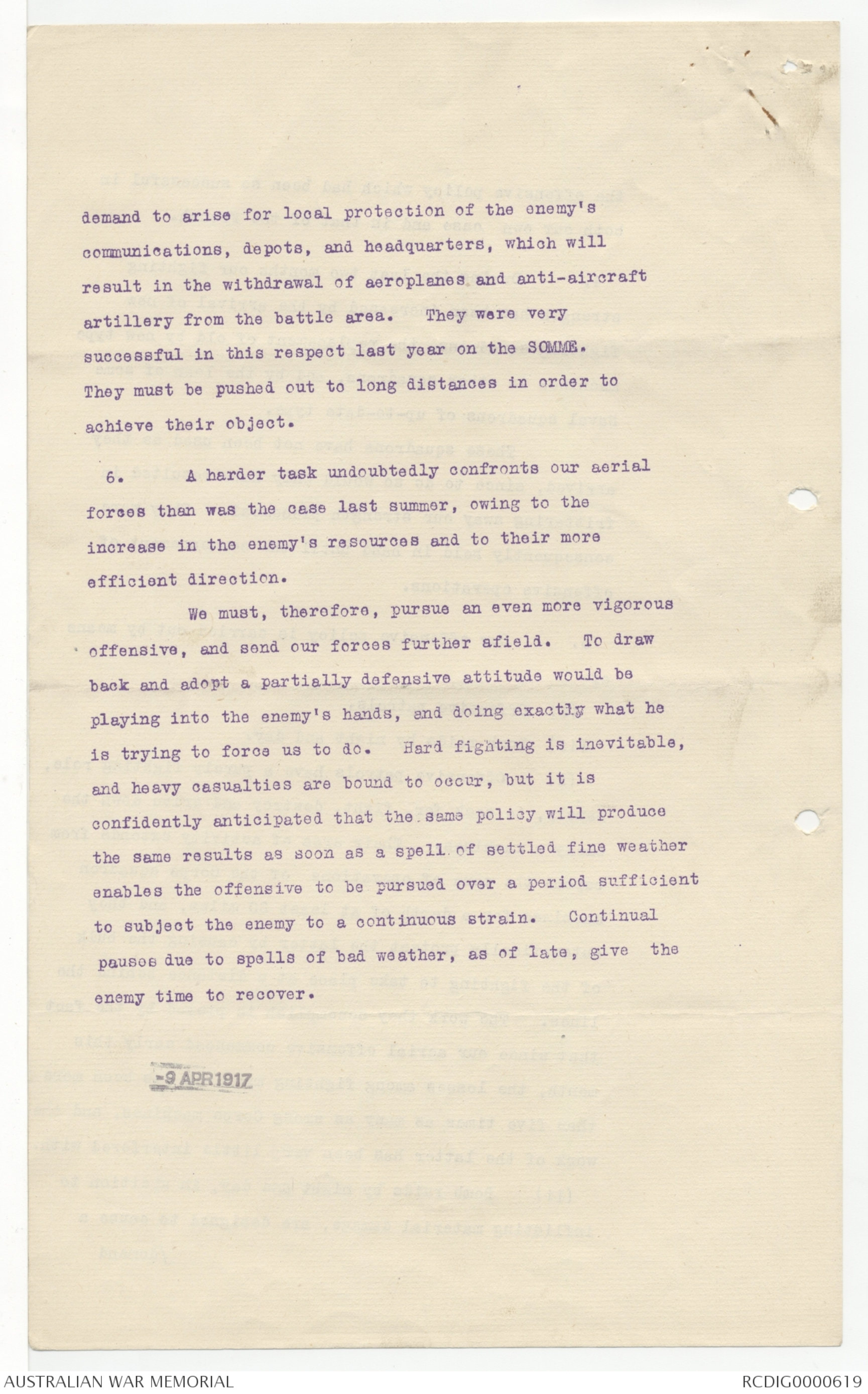
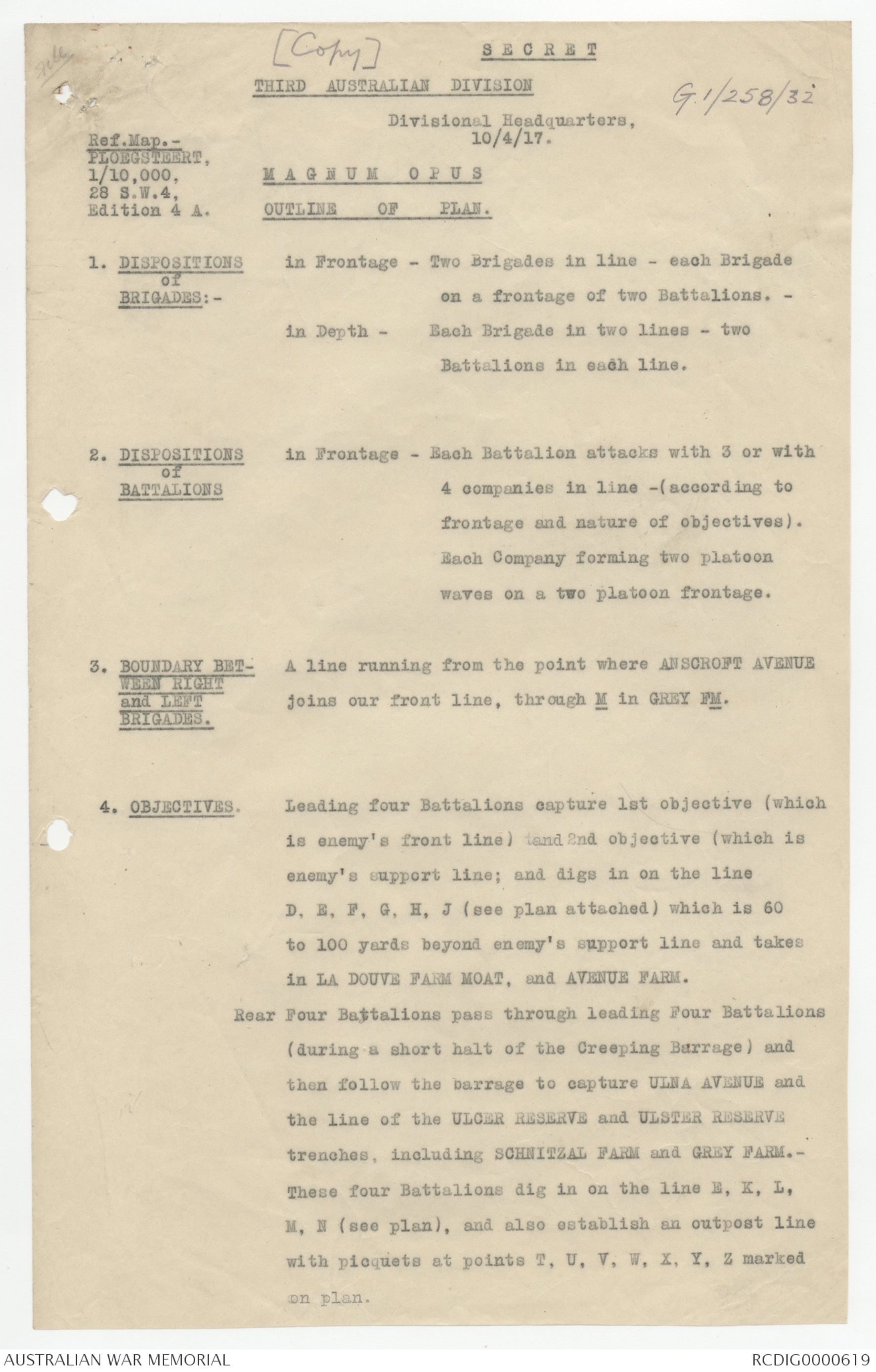
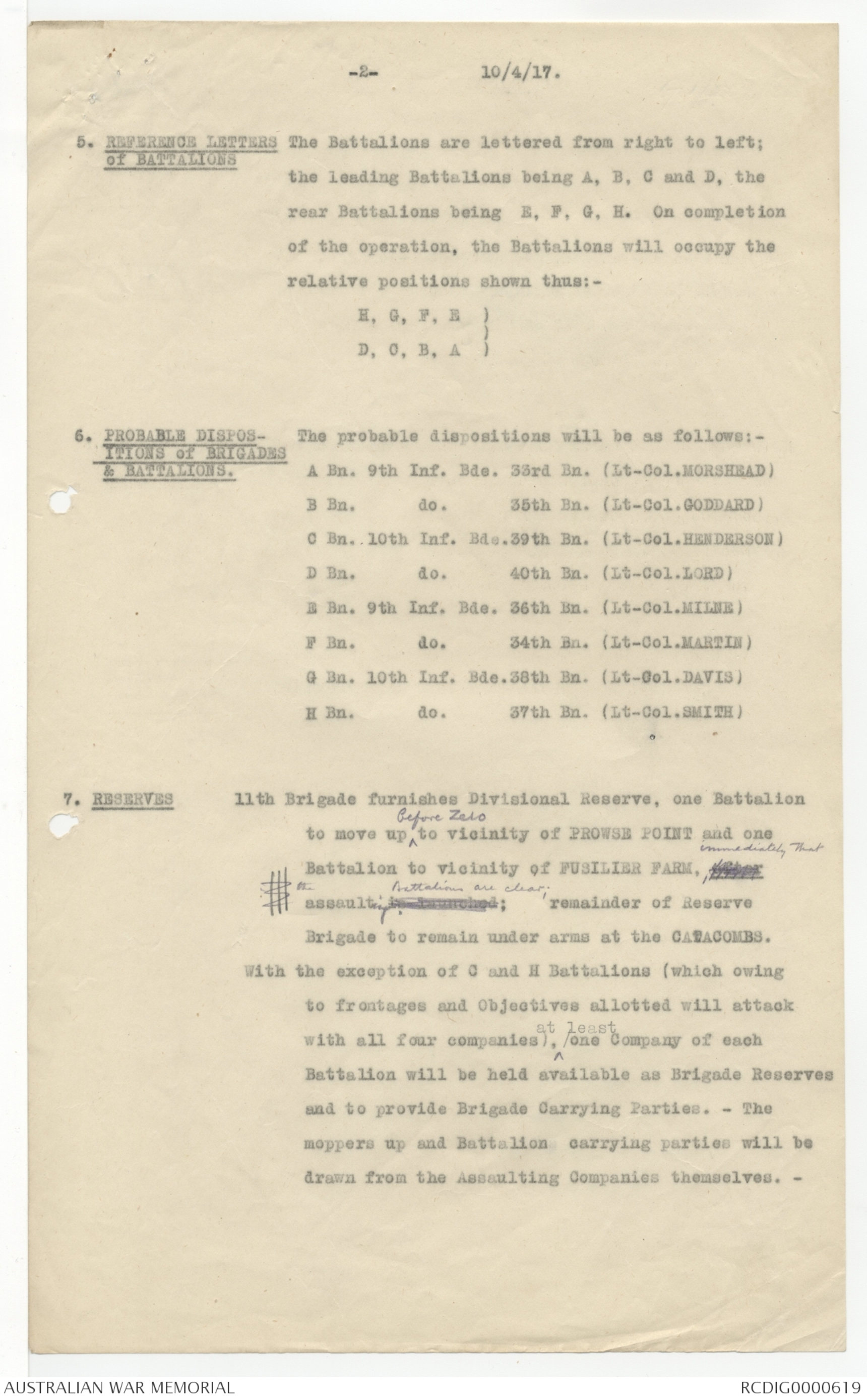
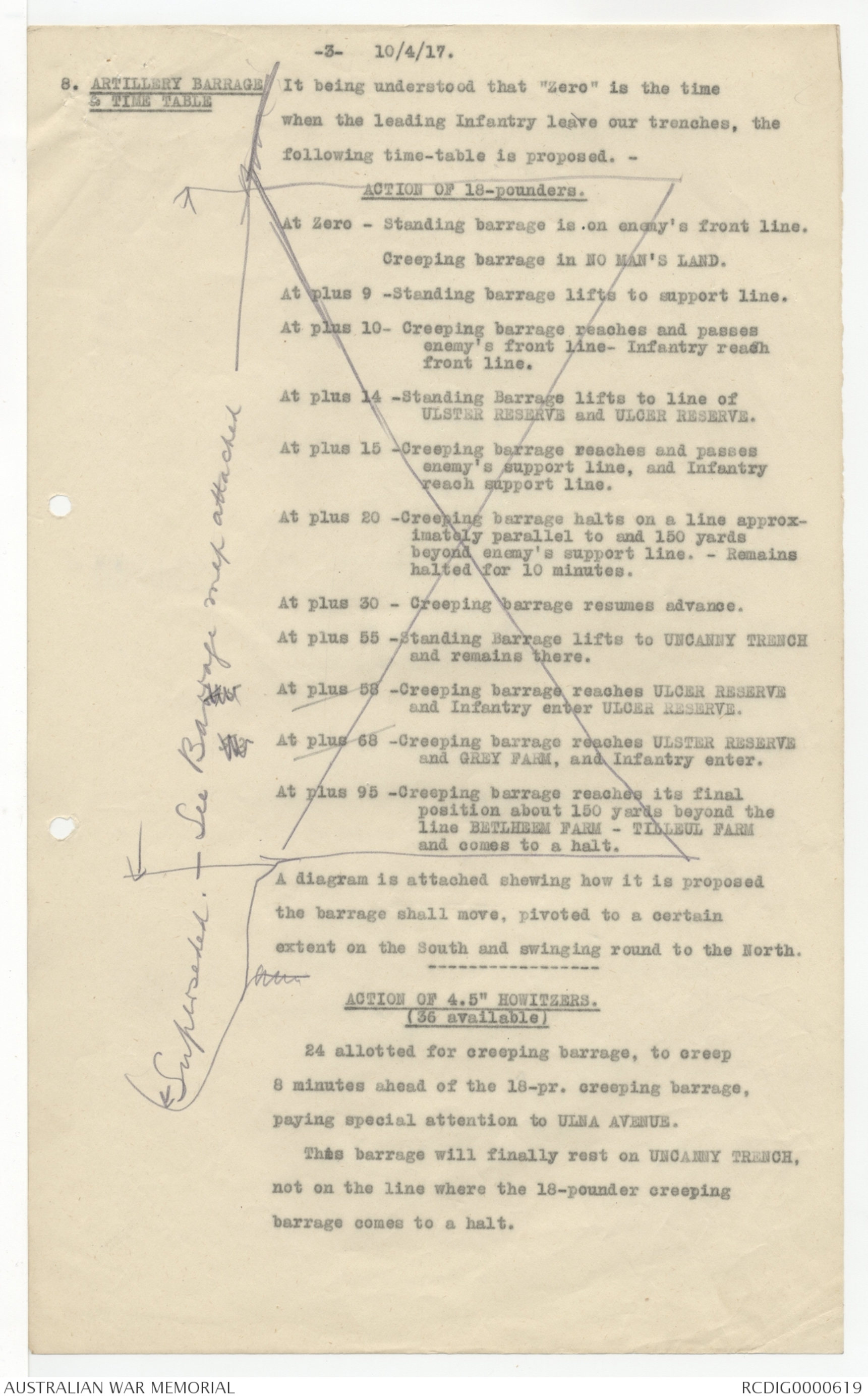
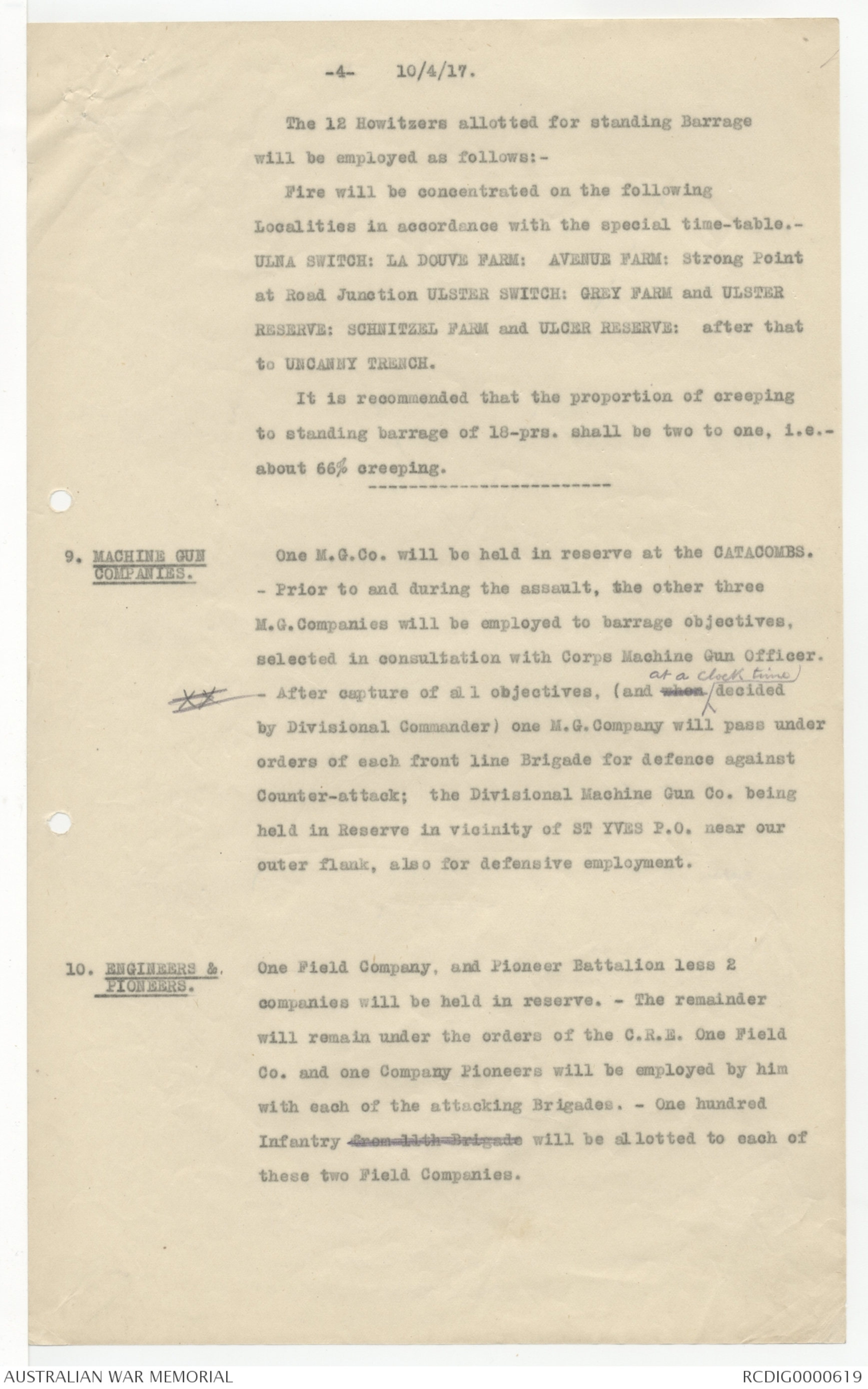

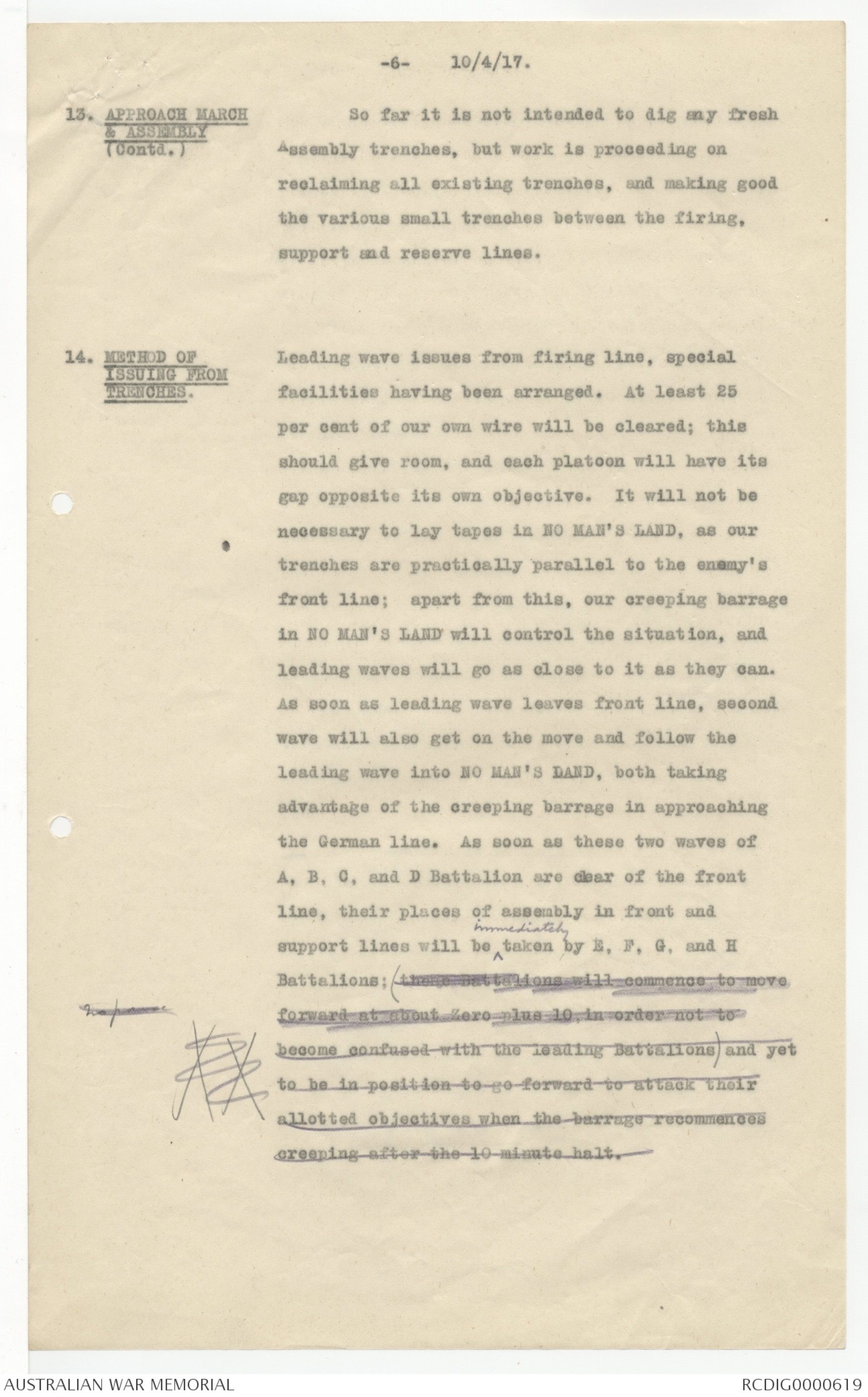
SECRET O.B./1837.
POLICY IN THE AIR
1. The whole value of the Royal Flying Corps lies
in its co-operation with the other arms and in the
assistance it can give to the conduct of operations on
the ground. Fighting in the air is not an end in itself,
but under present conditions it is a necessity to enable
this assistance to be given.
2. Fighting on the ground from the strategical
point of view may be offensive or defensive, or a
combination of the two, but in the air the offensive is
the only policy which cane give success. The aeroplane
is essentially an offensive and not a defensive weapon.
Owing to the unlimited space in the air which permits
of free manoeuvring in all three dimensions, to accidents
of wind and cloud, and to the difficulty of one machine
seeing another, no number of aeroplanes acting on the
defensive will prevent a hostile pilot with initiative
and determination from reaching his objective.
Appeals are often put forward for the direct
protection of our Corps squadron machines by escorts of
fighting machines. Apart from the fact that this would
entail a complete dissemination of our fighting strength,
this policy would not achieve the desired results. This
has been proved in actual practice. At the commencement
/ of the
of the VERDUN offensive last year, the French adopted
the offensive with their fighting machines.
Superiority in the air resulted at once, and their Corps
machines were enabled to do their work without undue
interference. As is happening now in our own case,
however, demands arose in some quarters for the direct
protection of these machines by escorts. These demands
were met, with the result that the enemy took the
offensive and turned the tables on the French. The
mistake was realised and rectified, and again the French
rapidly gained the ascendancy. Last Autumn the French
again tried the system of escorts, attaching four fighting
machines to each Corps squadron. Again, the policy was
found a mistake, and had to be abandoned.
3. Profiting by the French experience at VERDUN, we
pursued a relentless and incessant offensive in the air when
the operations on the SOMME front commenced last July.
This policy was completely successful, and gave us a marked
ascendancy for several months during which our Corps machines
were but seldom interfered with.
As was early foreseen to be inevitable, the enemy
took steps to re-equip his fighting squadrons with better
machines, and to introduce a more resolute and offensive
policy with the result that in the autumn of last year he
began to restore the balance, and during the winter we were
no longer able to claim the ascendancy we enjoyed last summer.
This situation was fully considered in August last
year, when it was first seen to be likely to arise, and it
was at once realised that the only possible way of meeting
it, and of once more obtaining the ascendancy, was to continue
/ the offensive
the offensive policy which had been so successful in
both our own case and in that of the French.
4. During the last two months our fighting
strength has been increased by the arrival of new
fighting squadrons, the replacement of old by new type
machines in other squadrons, and by the loan of some
Naval squadrons of up-to-date type.
These squadrons have not been used as they
arrived, since to do so would only have resulted in
frittering away our strength piecemeal. They were
consequently held in hand until the commencement of
offensive operations.
5. Our offensive policy is carried out by means
of
(i) Offensive patrols.
(ii) Bomb raids by night and day.
(i) Offensive patrols have a purely fighting role,
namely, to seek for, fight, destroy and drive down the
enemy's machines. Their area of activity extends from
beyond the zone of operations of the Corps squadron
machines for a depth of at least 20 miles, and they
automatically protect the latter by causing the bulk
of the fighting to take place at a distance behind the
lines. The work they accomplish is proved by the fact
that since our aerial offensive commenced early this
month, the losses among fighting machines has been more
than five times as many as among Corps machines, and the
work of the latter has been very little interfered with.
(ii) Bomb raids by night and day, in addition to
inflicting material damage, are designed to cause a
/ demand
demand to arise for local protection of the enemy's
communications, depots, and headquarters, which will
result in the withdrawal of aeroplanes and anti-aircraft
artillery from the battle area. They were very
successful in this respect last year on the SOMME.
They must be pushed out to long distances in order to
achieve their object.
6. A harder task undoubtedly confronts our aerial
forces than was the case last summer, owing to the
increase in the enemy's resources and to their more
efficient direction.
We must, therefore, pursue an even more vigorous
offensive, and send our forces further afield. To draw
back and adopt a partially defensive attitude would be
playing into the enemy's hands, and doing exactly what he
is trying to force us to do. Hard fighting is inevitable,
and heavy casualties are bound to occur, but it is
confidently anticipated that the same policy will produce
the same results as soon as a spell of settled fine weather
enables the offensive to be pursued over a period sufficient
to subject the enemy to a continuous strain. Continual
pauses due to spells of bad weather, as of late, give the
enemy to recover.
[*-9APR1917*]
[Copy] SECRET
THIRD AUSTRALIAN DIVISION G1/258/32
Divisional Headquarters,
10/4/17.
Ref.Map.-
PLOEGSTEERT,
1/10,000,
28 S.W.4,
Edition 4 A.
MAGNUM OPUS
OUTLINE OF PLAN.
1. DISPOSITIONS of BRIGADES :-
in Frontage - Two Brigades in line - each Brigade
on a frontage of two Battalions. -
in Depth - Each Brigade in two lines - two
Battalions in each line.
2. DISPOSITIONS of BATTALIONS
in Frontage - Each Battalion attacks with 3 or with
4 companies in line - (according to
frontage and nature of objectives).
Each Company forming two platoon
waves on a two platoon frontage.
3. BOUNDARY BETWEEN RIGHT and LEFT BRIGADES.
A line running from the point where ANSCROFT AVENUE
joins our front line, through M in GREY FM.
4. OBJECTIVES.
Leading four Battalions capture 1st objective (which
is enemy's front line) and 2nd objective (which is
enemy's support line; and digs in on the line
D, E, F, G, H, J (see plan attached) which is 60
to 100 yards beyond enemy's support line and takes
in LA DOUVE FARM MOAT, and AVENUE FARM.
Rear Four Battalions pass through leading Four Battalions
(during a short halt of the Creeping Barrage) and
then follow the barrage to capture ULNA AVENUE and
the line of the ULCER RESERVE and ULSTER RESERVE
trenches, including SCHNITZAL FARM and GREY FARM. -
These four Battalions dig in on the line E, K, L,
M, N, (see plan), and also establish an outpost line
with picquets at points T, U, V, W, X, Y, Z marked
on plan.
-2- 10/4/17.
5. REFERENCE LETTERS of BATTALIONS
The Battalions are lettered from right to left;
the leading Battalions being A, B, C and D, the
rear Battalions being E, F, G, H. On completion
of the operation, the Battalions will occupy the
relative positions shown thus: -
H, G, F, E )
)
D, C, B, A )
6. PROBABLE DISPOSITIONS of BRIGADES & BATTALIONS.
The probable dispositions will be as follows: -
A Bn. 9th Inf. Bde. 33rd Bn. (Lt.-Col.MORSHEAD)
B Bn. do. 35th Bn. (Lt.-Col.GODDARD)
C Bn. 10th Inf. Bde. 39th Bn. (Lt-Col.HENDERSON)
D Bn. do. 40th Bn. (Lt-Col.LORD)
E Bn. 9th Inf. Bde. 36th Bn. (Lt-Col.MILNE)
F Bn. do. 34th Bn. (Lt-Col.MARTIN)
G Bn. 10th Inf. Bde. 38th Bn. (Lt-Col.DAVIS)
H Bn. do. 37th Bn. (Lt-Col.SMITH)
7. RESERVES
11th Brigade furnishes Divisional Reserve, one Battalion
to move up ^before Zero to vicinity of PROWSE POINT and one
Battalion to vicinity of FUSILIER FARM, after immediately that
the assaulting is launched; Battalions are clear; remainder of Reserve
Brigade to remain under arms at the CATACOMBS.
With the exception of G and H Battalions (which owing
to frontages and Objectives allotted will attack
with all four companies), ^at least one Company of each
Battalion will be held available as Brigade Reserves
and to provide Brigade Carrying Parties. - The
moppers up and Battalion carrying parties will be
drawn from the Assaulting Companies themselves. -
-3- 10/4/17
8. ARTILLERY BARRAGE & TIME TABLE
It being understood that "Zero" is the time
when the leading Infantry leave our trenches, the
following time-table is proposed. -
[*SUPERSEDED -SEE BARRAGE MAP ATTACHED*]
ACTION OF 18-pounders.
At Zero - Standing barrage is on enemy's front line.
Creeping barrage in NO MAN'S LAND.
At plus 9 - Standing barrage lifts to support line.
At plus 10 - Creeping barrage reaches and passes
enemy's front line - Infantry reach
front line.
At plus 14 - Standing Barrage lifts to line of
ULSTER RESERVE and ULCER RESERVE.
At plus 15 - Creeping barrage reaches and passes
enemy's support line, and Infantry
reach support line.
At plus 20 - Creeping Barrage halts on a line approximately parallel to and 150 yards
beyond enemy's support line. Remains
halted for 10 minutes.
At plus 30 - Creeping barrage resumes advance.
At plus 55 - Standing Barrage lifts to UNCANNY TRENCH
and remains there.
At plus 58 - Creeping barrage reaches ULCER RESERVE
and Infantry enter ULCER RESERVE.
At plus 68 - Creeping barrage reaches ULSTER RESERVE
and GREY FARM, and Infantry enter.
At plus 95 - Creeping barrage reaches its final
position about 150 yards beyond the
line BETHLEHEM FARM -TILLEUL FARM
and comes to a halt.
A diagram is attached showing how it is proposed
the barrage shall move, pivoted to a certain
extent on the South and swinging round to the North.
ACTION OF 4.5" HOWITZERS.
(36 available)
24 allotted for creeping barrage, to creep
8 minutes ahead of the 18-pr. creeping barrage,
paying special attention to ULNA AVENUE.
This barrage will finally rest on UNCANNY TRENCH,
not on the line where the 18-pounder creeping
barrage comes to a halt.
-4- 10/4/17.
The 12 Howitzers allotted for standing Barrage
will be employed as follows :-
Fire will be concentrated on the following
Localities in accordance with the special time-table.-
ULNA SWITCH: LA DOUVE FARM: AVENUE FARM: Strong Point
at Road Junction ULSTER SWITCH: GREY FARM AND ULSTER
RESERVE: SCHNITZEL FARM and ULCER RESERVE: after that
to UNCANNY TRENCH.
It is recommended that the proportion of creeping
to standing barrage of 18-prs. shall be two to one. i.e.-
about 66% creeping.
9. MACHINE GUN COMPANIES.
One M.G.Co. will be held in reserve at the CATACOMBS.
- Prior to and during the assault, the other three
M.G.Companies will be employed to barrage objectives,
selected in consultation with Corps Machine Gun Officer.
- After capture of all objectives, (and when ^at a clock time decided
by Divisional Commander) one M.G.Company will pass under
orders of each front line Brigade for defence against
Counter-attack; the Divisional Machine Gun Co. being
held in Reserve in vicinity of ST YVES P.O. near our
outer flank, also for defensive employment.
10. ENGINEERS & PIONEERS.
One Field Company, and Pioneer Battalion less 2
companies will be held in reserve. - The remainder
will remain under the orders of the C.R.E. One Field
Co. and one Company Pioneers will be employed by him
with each of the attacking Brigades. - One hundred
Infantry from 11th Brigade will be allotted to each of
these two Field Companies.
-5- 10/4/17.
10. ENGINEERS & PIONEERS (Contd.)
Special Tasks. - Communications across NO MAN'S LAND
Formation of Strong Points in our
new lines.
Clearing overland routes in captured
territory.
Bridging LA DOUVE RIVER.
Defensive wiring (if ordered) in
front of right Brigade.
11. MEDIUM TRENCH MORTARS.
These will be employed in cutting wire prior to
Zero; during the "time-table" they will participate
in the barrage of enemy front line from Zero to
Zero plus 5 minutes.
12.LIGHT TRENCH MORTARS.
One Battery is held in reserve. - One Battery remains
at disposal of each attacking Brigade, to move
forward, under Brigadier's orders, into captured
territory, for employment defensively, and to
engage any suitable targets within range, -
particularly on the new front of the right Brigade.
13. APPROACH MARCH & ASSEMBLY
The following communication trenches are being made
good for use during the Approach March and subsequently.
- ASH LANE: THE ONLY WAY: ANNSCROFT
AVENUE: ONTARIO AVENUE: TORONTO AVENUE: ST YVES
AVENUE.
This will allow three for each Brigade.
ASH LANE will cross LA HUTTE-MESSINES Road by
means of a tunnel. Special precautions will be
taken to make this so strong that the roadway will
not be interfered with and will be capable of
carrying heavy traffic.
In addition to the above communication
trenches, special lines over the top of the ground
will be laid out.
-6- 10/4/17.
13. APPROACH MARCH & ASSEMBLY (Contd.)
So far it is not intended to dig any fresh
Assembly trenches, but work is proceeding on
reclaiming all existing trenches, and making good
the various small trenches between the firing,
support and reserve lines.
14. METHOD OF ISSUING FROM TRENCHES.
Leading wave issues from firing line, special
facilities having been arranged. At least 25
per cent of our own wire will be cleared; this
should give room, and each platoon will have its
gap opposite its own objective. It will not be
necessary to lay tapes in NO MAN'S LAND, as our
trenches are practically parallel to the enemy's
front line; apart from this, our creeping barrage
in NO MAN'S LAND will control the situation, and
leading waves will go as close to it as they can.
As soon as leading wave leaves front line, second
wave will also get on the move and follow the
leading wave into NO MAN'S LAND, both taking
advantage of the creeping barrage in approaching
the German line. As soon as these two waves of
A. B. C. and D Battalion are clear of the front
line, their places of assembly in front and
support lines will be ^immediately taken by E, F, G, and H
Battalions; (these Battalions will commence to move forward at about Zero plus 10, in order not to become confused with the leading Battalions) and yet to be in position to go forward to attack their allotted objectives when the barrage recommences creeping after the 10 minute halt.
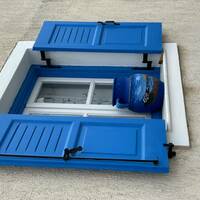 Jen
Jen This transcription item is now locked to you for editing. To release the lock either Save your changes or Cancel.
This lock will be automatically released after 60 minutes of inactivity.